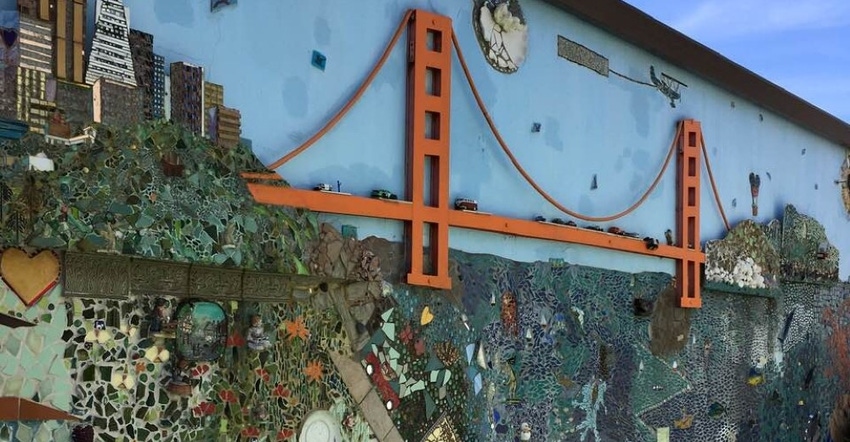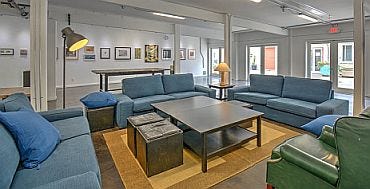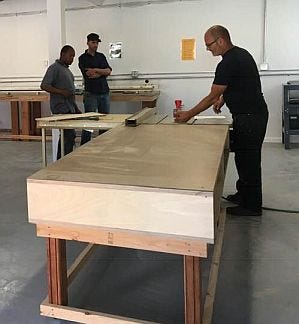Getting to Add-On Profit: Bridge Storage and ArtSpace and Its Creative Revenue Model
Bridge Storage and ArtSpace isn’t your traditional self-storage facility. Read how this Richmond, Calif., operation transformed itself by adding art and event space and catering to the creative needs of its community.

Family-owned and -operated for nearly 20 years, Bridge Storage and ArtSpace in Richmond, Calif., is a multi-use self-storage facility that transformed itself in 2011 by adaptively reusing storage space as art and music studios. After connecting with local artists who were already our self-storage tenants and discovering their needs, we redeveloped 5,000 square feet of units into 28 studio spaces. We also added an active gallery that displays the work of artists, musicians, carpenters and others, even if they don’t rent with us.
In many ways, the facility has become an events and community center. We’ve hosted art exhibits, music events, record swaps, cultural gatherings, holiday events and film screenings. Together, these have served as a catalyst for community-building in our Santa Fe neighborhood as well as nearby Point Richmond.
A Silver Lining
Sadly, on Dec. 2, 2016, a horrific fire at an Oakland, Calif., warehouse known as the Ghost Ship killed 36 people. The tragedy prompted city officials to take a long, hard look at spaces being used by artists in Richmond. Just days after the Ghost Ship fire, city inspectors visited our facility and red-tagged the property. We were ordered to come into full zoning and code compliance before we could allow our artists back in to work.

The greenscreen studio
Undeterred, we reconfigured spaces; upgraded electrical service; installed insulation, drywall and heating systems; and equipped the property with fire sprinklers throughout. Though it was a disruption, we saw the silver lining in refining our infrastructure and business model to be much more effective. Bridge now runs on a hybrid shared- and private-workspace model, with a membership that includes artists, makers and entrepreneurs.
Upgrades include new meeting rooms, plus a woodshop, art studio and metal shop that added valuable resources for our members. We also converted a building into Bridge FilmSpace, a small studio suitable for making videos, commercials and short films. We even recently opened a 400-square-foot commercial kitchen for aspiring food entrepreneurs and to feed our growing community!
Fostering Community
By itself, self-storage is a business model with good cash flow. Though we could probably make a better return on investment (ROI) by sticking solely with storage, we see our ROI as being beyond financial returns. We’re investing in our community. We’re fostering friendships and connections. We love to see guests step inside our gate and be surprised and delighted by the landscaped grounds, art and musical instruments. Customers sometimes even want to pay more for storage. Most important, though, is the intangible value we receive by being part of and giving back to our community in a real way.

Coworking gallery space
A nice side effect of adding all these community-oriented amenities has been helping to improve the safety of our neighborhood. Our surrounding area has been challenged by dumping, drug and gang activity. The local Crime Prevention Committee recently named us its “Business of the Year” for our safety and crime-reduction efforts. “In the process of developing the ArtSpace, Bridge has transformed the lower block of Maine Avenue from a traditional drug corner into a busy neighborhood with persons from many walks of life visiting throughout the day and night, partaking in arts and culture activities,” the neighborhood council said in honoring the facility.
Opportunity in Circumstance
Believe it or not, the services we offer have chosen themselves. During the Great Recession, some of our storage clients went out of business. We inherited their inventory and ended up creating a showroom to sell it. That showroom ultimately became an art gallery and meeting room, which led to some early venue rentals.
We also had artists working on site in their storage units, so we decided to create workspace for them. Before long, we had cabinet makers show up, so we added a shared woodworking space. As a result, we wound up purchasing or inheriting power tools and equipment on a scale larger than most could accommodate in their home studios, which became a draw. This is similar to the idea behind our commercial kitchen. By providing access to space, tools and services, we’re helping artists become entrepreneurs.
Challenges of Implementation
Most of the challenges we’ve faced have been from permitting issues with the city. As we all know, self-storage units aren’t meant for human occupation. A lot of work has gone into redesigning our structures and bringing them up to code. In some cases, we’ve even rezoned portions of our site.

The woodshop
Another hurdle has been in simply designing our model to accommodate all of these varied businesses. From marketing to pricing to implementation, it’s been quite a process. The good news is that by working 200 square feet at a time (about the size of a typical storage unit), we’re able to experiment and iterate until we get it right. Our story is really a new way of doing adaptive reuse in commercial development.
Growing the Business
In the early days, we opened our doors and grew organically. We started out with events and art openings as a way to foster community and show off our amenities. During the last few years, we’ve upped our quality game and taken a more focused and strategic approach to growth. We’ve partnered with local nonprofits, neighborhood groups and arts organizations to offer cultural events and classes, which has put us on the map as a vital force for good in our community. We also maintain a strong online and social media presence.
In terms of rental income, our revenue per square foot for art space is only marginally higher than for self-storage. We’re encouraged by the promising “gym” model we’ve got for coworking space, and we’re on track to grow there. In the meantime, we’re nearly always at full self-storage capacity despite being able to charge more than our competitors. Self-storage still comprises about 80 percent of our space. Surprisingly, many customers are willing to pay a little more to store their items in a place that’s full of life, creativity and art.
More Than Profit
Self-storage is profitable on its own. For other operators who may consider embarking on a path similar to ours, we’d encourage you to contemplate whether you want to expand your concept to include your community. It’s really about how you define profit. We run this business in a triple-bottom-line way. We’re committed to social and environmental concerns as well as running a financially viable business. It gives us meaning in our work.
A successful conversion or transformation like ours begins with having a serious conversation with local authorities, including planning, building and fire departments. For any operator considering this path, we’re happy to share our experience and offer feedback on any plans. Please feel free to reach out!
Iris AlRoy is marketing director and Jeff Wright is owner of Bridge Storage and ArtSpace. Iris joined the company in 2017 with a background in marketing, project management and content production. She’s contributed to the company’s expansion from self-storage to a multi-channel business. After 15 years as a math professor at the University of San Diego, Jeff worked with his late father, Jim Wright, to manage and grow the storage facility, which Jim built in 1997. He’s spearheaded the development as a vehicle for transforming underutilized and challenged properties into vibrant, community-centered rental operations. For more information, visit www.bridgestorage.com.
About the Author(s)
You May Also Like





